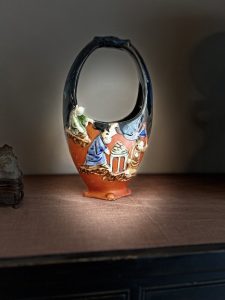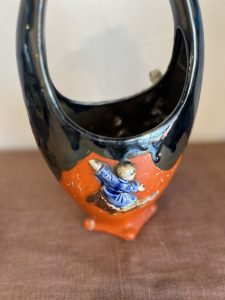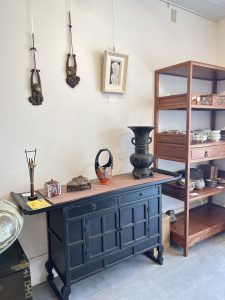隅田焼をながめながら(愛知県名古屋市千種区姫池通 骨董買取 古美術風光舎)
2025.06.19

実は、隅田焼を目にするのは初めてでして。
面白いですね、ずっと目線が追ってしまうんですよ…。ふざけが発動して大喜利みたいに思わずセリフをつけてしまいそうですが、それはやめておくとして。


隅田焼の特徴でもあるこのモチーフが気になって、他にもいろいろ隅田焼の作品を検索したりして見たいたのですが、立体でリアルなその人物や動物などの一つ一つにストーリーがあり、またその一つ一つのストーリが器全体にループして繋がっていくようであります。ぐるぐると器に広がる永遠に終わらないストーリーを知らず知らずじっと追ってしまうのですが、たとえばこれが陶板だったとしたら、ストーリーは陶板の端で途切れてしまったのでしょうね。
さてさてこの隅田焼、あの東京の隅田の辺りの焼き物?隅田にそんな焼き物の土の採れるところなんてあったのか?なんて普通思えてくるのだが。場所はあの隅田で間違いないのですが、ルーツは実は愛知県瀬戸市にあるようです。
隅田焼の始まりは幕末。瀬戸の初代井上良齋が江戸へ行って製陶を始め、明治8年(1875)に島田惣兵衛の協力で隅田川西岸の橋場町で瀬戸伝統の登り窯を築きます。その土は瀬戸から蛙目粘土を運び、陶磁器に器面に貼り付けた炻器質のやきもの造形物(ストーンウェア)を貼り付ける高浮彫の技法で装飾され、赤や黒の塗料し、上部に釉薬をかけ流し仕上げる独特の作風であります。
今までの日本の陶磁器にはなかった自由奔放な表現が江戸の文化を漂わせてその独特の作風が魅力でして、当時から盛んに欧米に輸出されたようで、初代や二代良齊を慕って故郷の瀬戸からやってきた人々も窯で学んでいたそうです。
なんといてもその特徴はそのモチーフなのですが、江戸情緒を感じさせる愛すべき町人風の人物や子ども、仏教や僧侶、猿、象、龍、虎などのエキゾチックなモチーフを立体的に造形し器面に貼り付けられています。また、浅草に近いため相撲に関わる作品も見られ親近感も感じられたり。
またその独特の色彩もモチーフをいきいきとさせているようにも思えます。釉薬をかけず露胎の部分は、上絵の具を焼き付けるのではなく、赤や黒の塗料を使って仕上げてるのですが、瀬戸では上絵付きの技術が発達していなかったこととや、輸出にあたり東洋の魅力をイメージさせた漆の色を表現したことにもあるようですね。
これらは、もしかしたら瀬戸から江戸に出てきた初代井上良齋が、江戸の華やかな町文化に触れて驚いたことや珍しい風景に魅了され、それらを表現したかったのかなと勝手に思っているのですが、そんな初代井上良齋が驚いた風景が意外にも海外の方にもウケたのでしょうか笑。海外の方にもその日常のモチーフや色使いが新鮮にそして魅力的に映ったのでしょうね。
また、この隅田焼の二代良齋は明治33年(1900)にパリ万国博覧会で金牌を受賞しています。ですが二代良齋は現地で轆轤の妙技を披露して間もなく逝去します。帝室技芸員任命を夢見た人々は彼の死を惜しんだといいますから、もし彼が帝室技芸員に任命されていたとしたら、隅田焼の歴史も少しかわっていたのかな…。
そのくらい令和生きる自分にもまだまだインパクトのある隅田焼でありました。
それではごきげんよう(スタッフY)

Actually, this is the first time I’ve seen Sumida-yaki.
It’s funny, my eyes follow it all the way…. I feel like my joking around might be triggered and I might unintentionally add a line like a big joke, but I’m not going to do that.
I was curious about this motif, which is a characteristic of Sumida-yaki, and I wanted to search for other Sumida-yaki works to see them. If this were a ceramic plate, for example, the story would have been interrupted at the edge of the plate.
Now, is this Sumida-yaki pottery from the Sumida area of Tokyo? Was there a place in Sumida where such clay for pottery could be found? It seems to me that there was no place in Sumida where such clay for pottery could be found. The location is definitely that Sumida, but the roots of Sumida-yaki are actually in Seto City, Aichi Prefecture.
Sumida pottery began at the end of the Edo period. Ryosai Inoue, the first generation of Seto potters, went to Edo to begin pottery making, and in 1875, with the help of Sohei Shimada, he built a traditional Seto climbing kiln in Hashiba-cho on the west bank of the Sumida River. The clay was brought from Seto and decorated with the high relief technique of pasting stoneware on the surface of the ceramic ware, which was painted red or black and glazed over the top to create a unique style.
The free and unrestrained expression that had never been seen in Japanese ceramics until now was an appealing characteristic of the Edo culture, and it was actively exported to Europe and the U.S. from that time.
The most distinctive feature of this pottery is its motifs, which include lovable Edo style people, children, Buddhism, Buddhist monks, monkeys, elephants, dragons, tigers, and other exotic motifs, which are sculpted and pasted on the surface. Also, because of its proximity to Asakusa, some of the works are related to sumo wrestling, giving visitors a sense of familiarity with the sport.
The unique colors also seem to bring the motifs to life. The unglazed, exposed areas are finished with red and black paints instead of overglaze paints, which may be due to the fact that overglaze painting techniques were not developed in Seto, and also due to the lacquer colors used for export, which evoke an oriental charm.
I wonder if Ryosai Inoue I, who came to Edo from Seto, was surprised by the gorgeous town culture of Edo and was fascinated by the unusual scenery and wanted to express them. The motifs and colors of everyday life must have looked fresh and attractive to foreign people.
Ryosai Ⅱ of Sumida-yaki was awarded a gold medal at the World Exposition in Paris in 1900, but Ryosai Ⅱ did not win the gold medal there. However, Ryosai II passed away shortly after demonstrating his skill on the potter’s wheel there. It is said that those who dreamed of being appointed as a member of the Imperial Household Artisans regretted his death, so if he had been appointed as a member of the Imperial Household Artisans, the history of Sumida-yaki would have been a little different….
Sumida-yaki still has such an impact on me, even though I live in 2038.
Have a good day (Staff Y)
*******************
ご実家の整理やお片付けなどをされている方のご相談などが多くございます。
お片付けなどくれぐれもご無理のないようになさってくださいませ。
風光舎では古美術品や骨董品の他にも絵画や宝石、趣味のお品など様々なジャンルのものを買受しております。
お片付けをされていて、こういうものでもいいのかしらと迷われているものでも、どうぞお気軽にご相談下さいませ。
また風光舎は、出張買取も強化しております。ご近所はもちろん、愛知県内、岐阜県、三重県その他の県へも出張いたします。
まずは、お電話お待ちしております。
愛知県名古屋市千種区姫池通
骨董 買取【古美術 風光舎 名古屋店】
TEL052(734)8444
10:00-18:00 OPEN

